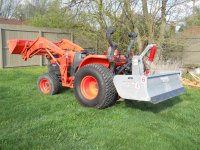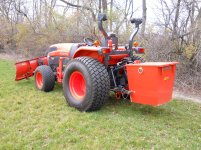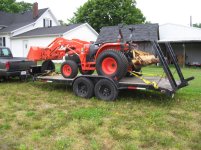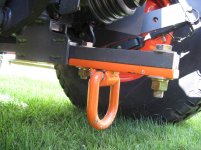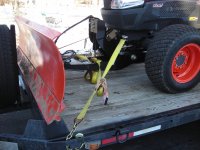After reading all the comments, most of them are accurate (a few inaccurate statements). First thing you need to do is widen the stance of the wheels to the widest setting possible for loader work especially if working on hills. Try to make the fronts the same as the rears (outside tire measurement on each wheel). After the tires are widened, have liquid ballast installed in the rear tires. Most CUT mfg. don't recommend loading the fronts. Front tire spacing WILL help in stability and those saying that it doesn't because they swivel are making an untrue assumption. Yes they swivel on a center frame pin, BUT, they only a few inches in either direction till they bump the frame and then it becomes a solid unmovable axle. Raise the front off the ground with the FEL (dump the bucket fully so the bucket bottom is vertical, this gives you max lift height) and you can see how much they swivel and then hit the stop. This stop is a long way from maximum tip angle so front does provide stability.
As for loading the tires, pick your material, Rimguard, water with methanol, water with antifreeze or if in mild climate like I am just plain water. Having liquid ballast in the rear tires makes the tractor much more stable. Remember move the tires out to max width prior to filling because on most tractors to do this you have to swap tires side to side ( left to the right side and vice versa).
You said you have rear counterweight of more than 1000# so I don't think you need any more. I think your biggest problem is lack of experience with the loader as there is no way a FEL bucket should make the tractor feel unstable. You just need to get the feel of the tractor. ONE way to check out the stability is to raise the bucket about a foot off the ground and while on level ground run the ground speed up to lets say about 5 MPH and then jam on both brakes so the rear tires are skidding. If the bucket doesn't tip to the ground, you are not unstable. You can do the same thing with a full bucket but not travel but like a slow walking speed and hit the brakes, if the rear wheels don't come off the ground, you aren't overloaded. Much or bad experience comes from operations that exceed the capacity. When you are near capacity for tipping forward as described above, you have to be really careful and go very slow especially on any slope. IT doesn't take much to tip your tractor when traveling side to side on a slope and even less if attempting a turn on a slope at high speed with a loaded bucket. Always travel with a loaded bucket just high enough to clear obstacles and with one hand always on the FEL joystick and if you feel you are toppling, drop the load quickly. This is not meant to scare you but advise you on how to adjust to a sometimes unpleasant situation.
Summary or my long winded post:
1. Widen wheels (if you don't know how, get the dealer to do it for you and then liquid ballast them for you)
2. Ballast the tires
3. Put a heavy counter weight on the 3 point hitch. I use my 1500# bush hog which sticks WAY back behind me so I get maximum counter weight for my 3500# lift capacity but it is long and takes lots of room to maneuver.
4. Finally get the feel of your tractors capacity by operating it. The more you operate it the better you will feel on it.
I went from having a small 45HP open station tractor that I basically straddled the frame so I sat close to the ground to my 70HP Utility tractor with cab that the operators platform is over chest high so I am really up in the air. It takes some getting used to, but once you run the tractor for a few days, it gets smaller and smaller.
